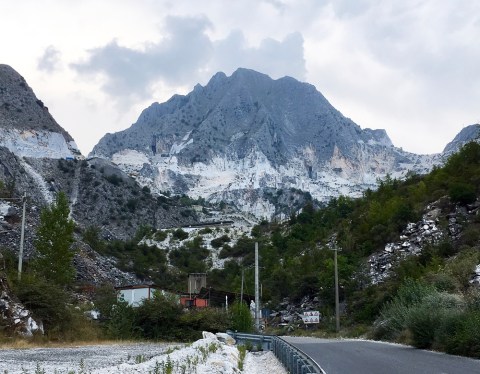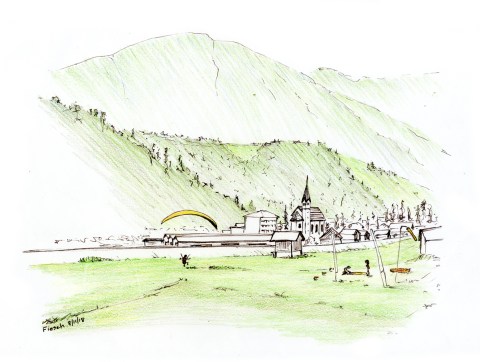Stone Topo Models
The other thing, along with drawing, that saved Venice for me was going to the Biennale. I hadn’t planned on going, but it was out of the heat and away from the main tourist hordes and in the end I liked it a lot.
I found a lot of the pavilions interesting. Maybe the best was the German exhibition about the Berlin Wall, with a couple of perspective games — isolated panels that from a certain vantage point appeared to be a continuos wall, and a mirror trick that made the wall appear infinite — and genuinely interesting info about the wall’s past and present. I gave it my highest rating, a full Hasselhoff.
But my favorite was the Mexico exhibition: architectural models fabricated in stone and mounted as wall panels. Maybe I’m the exact target audience. Afterwards I found it was completely absent from all of the ‘best of the biennale’ listicles; maybe it’s not flashy enough, there’s a lot of gray and a lot of the same stone. But I think it’s a great series; there’s a nice range of scales, a varying degree of abstraction, and the fabricators used a few different techniques to make the models.
Another half dozen are below. Read the rest of this entry »
Italy Drawings
Bolgona, Via Rizzoli
These are my drawings from Italy. Mostly piazzas. I found it very pleasant to sit at a cafe or on some steps and draw a lovely Italian piazza. Towards the end are a bunch of bridges in Venice. Drawing saved Venice for me. I was shocked by the onslaught of crowds and felt bad to be a part of it, but I eventually found a bench to sit and draw Piazza San Marcos, and it felt like catching my breath. Later I drew a bunch of the bridges and ignored everyone taking selfies on them. I missed a lot of the famous sites, but I felt good about what I did see and glad I got to see such a unique city. Venice is amazing, Italy is amazing, I hope to go back as soon as next summer. Read the rest of this entry »
Jorge Jimenez Deredia Sculptures in Lucca
Along with Carrara, one of the other places I ended up visiting instead of Florence was Lucca, a town which turned out to be great. I’d never heard of it, but apparently it’s a popular destination; Italy has no end of wonderful places to visit and a couple of my favorite places were ones I’d never heard of beforehand. And instead of seeing David, I got to see a lovely outdoor exhibition of sculptures by Jorge Jimenez Deredia that were scattered throughout Lucca’s old town. Deredia is a Costa Rican sculptor who has lived in Italy since the 70’s. He does a nice job of synthesizing classical and modern, old world and new, figurative and abstract. The most impressive is this one here, which was sited just outside the gate to the old town. It’s huge, hopefully the photos give a sense of its scale.
I think the marble is from the nearby Carrara quarries I showed in my last couple posts. He has studied and had a workshop there, and the stone looks right for Carrara, with lovely flecks of gray mixed into the white marble. There’s a softness and fleshiness to it, really beautiful.
He also works in black granite and bronze. I’m rarely interested in bronzes, but his are great. He credits seeing the Boruca spheres in his native Costa Rica at age nine as the foundational moment of his art, and pretty much everything he does relates to the sphere. From what I can tell, he does three things: curvy women, curvy women interacting with spheres, and quadtychs that show spheres transforming into curvy women. The Lucca exhibition didn’t have any of the complete quadtychs, but the works on exhibit made a nice overview and a fun objective as I pedaled around the town center looking for them.
A couple more are below. His website shows more of his work and includes some worthwhile videos, including two that show the installation at Lucca and one that shows the creation of a large bronze. Read the rest of this entry »
John Singer Sargent’s Carrara Watercolors
One of the reasons I wanted to go to Carrara, I’m not ashamed to admit, is because James Bond had a car chase there. Switchbacks, stone, and big machines, sign me up. Another reason is Edward Burtynsky’s stunning photos. His book, Quarries, features Carrara on the cover and first convinced me that the landscape would be beautiful. But probably the biggest reason is the series of paintings by my favorite watercolorist, John Singer Sargent. I’ve never seen them in person and I’m not sure how many he actually did, but for years I’ve grabbed them off the internet whenever I’ve seen them. They might not be as important as his paintings of Venice and I’m sure I attach more importance to them than most other people, but it’s the world’s greatest watercolorist painting one of the world’s great cultural landscapes. Fantastic.
Titles and dates for most of them can be found at the John Singer Sargent Virtual Gallery, along with some pencil studies that are interesting to see. As I understand it, he visited the quarries twice, in 1911 and 1913, the era of dynamite and oxen at the quarries, before the workers had the big machines and the wire saws they use today. I love how many of the paintings show workers carrying ropes up the mountain. The weight of the stone is obvious, but I’m fascinated too by how heavy the ropes would have been and how much effort would have been put into just moving them around. Not an easy place to work.
Another dozen more are below. Read the rest of this entry »
Carrara
Originally on my trip I had planned to go to Florence, but, after realizing how crowded it would be, I headed towards the coast. Instead of waiting in a long line and shuffling past Michelangelo’s David, I decided I’d rather ride around on the mountain where they quarried the marble for it. I still want to see David, but I’ve no regrets, Carrara is awesome. It has a sculptural quality equal to any statue. I didn’t quite capture it in the photo above, but the quarries girdling the mountain are creating a two-toned effect, weathered gray rock above a shining marble pedestal. It’s not as dramatic as the Cuernos del Paine, where glaciers created the two-toned effect instead of humans, but it’s the closest I’ve ever seen and an amazing by-product of the quarries.
That’s a beautiful cliff face. Many quarries are ugly scars, but not Carrara. I took a tour with Cave di Marmo, and then cycled around on the roads that are open to the public. It wasn’t quite as exciting as driving an Aston Martin with thugs shooting machine guns at me, but the downhills were fun, and a long unlit tunnel was sort of scary.
There was a ridge or saddle here in the past, and the quarrying is making separate peaks.
The current process in Carrara is to start at the top and work down in benches ten meters deep. They drill three holes — one from the top and two from the sides — that meet at a single point and then they run a cable with diamond-crusted studs through the holes to make a loop. The cable spins very fast and slices the stone, first one side, then the other, and then the bottom. Then with machines they tip the block over onto a bed of rubble and break it down into smaller blocks to haul down the mountain and ship all over the world.
The piles of rubble in the photos are there for practical reasons, to cushion the landing of the blocks as they are pulled away from the cliff, rather than sloppy housekeeping. I posted a movie trailer with footage from Carrara showing the process a few years ago. Since then I’ve seen the full movie, it’s great, highly recommended.
They use water to cool the cable as it cuts, so you see large puddles of milky water everywhere they are actively cutting. They fill the water tanks from springs coming out of the mountain, delicious marble-filtered water I had a chance to taste while I was riding around. I saw a trucker pull over to fill his water bottle at a roadside spring. I asked if it was ‘Buona’ and he said ‘Buonissima!!!’ Like holy water for a mason or something, perhaps my chisel will now carve with greater acuity.
It looks like a slow unhurried process with only a few people working at a time, but then you realize the size of the stone blocks they are pulling off the mountainside.
Switzerland Drawings
These are my drawings from Switzerland. They loosely track my progress across the country. The furthest west is from Lausanne on Lake Geneva. The last is a view from Guarda, a town in the lower Engadine near the Austrian border. The interior view and the pool are from Therme Vals, Peter Zumthor’s phenomenal thermal baths.



























